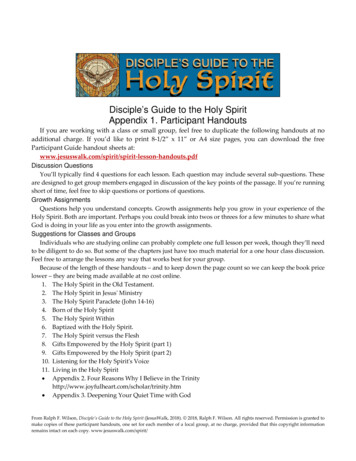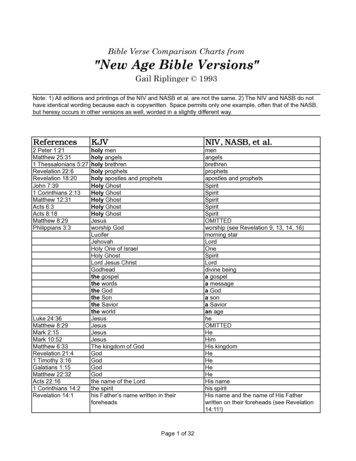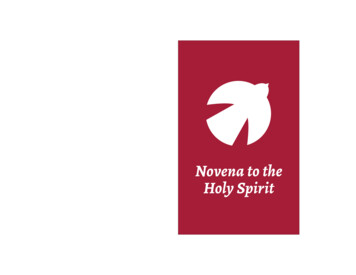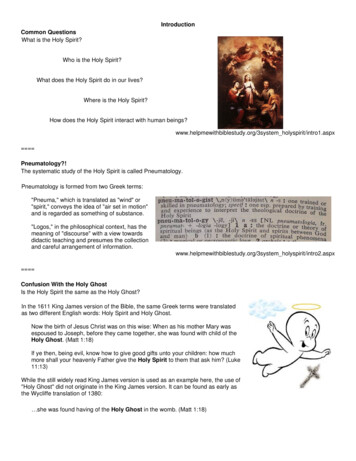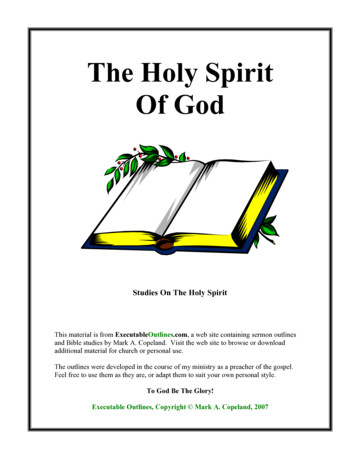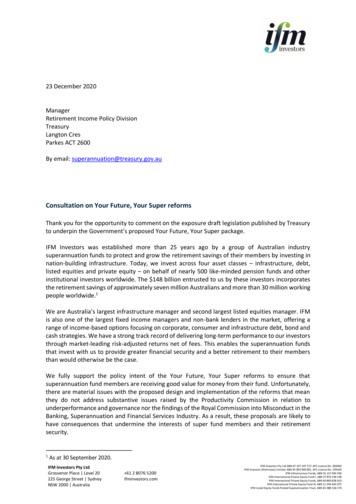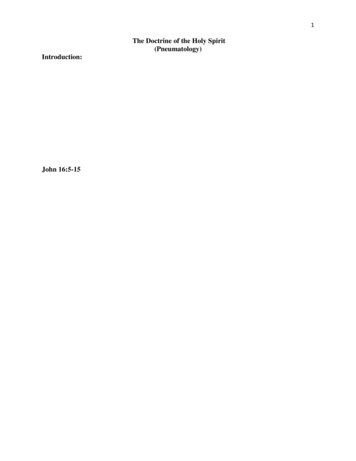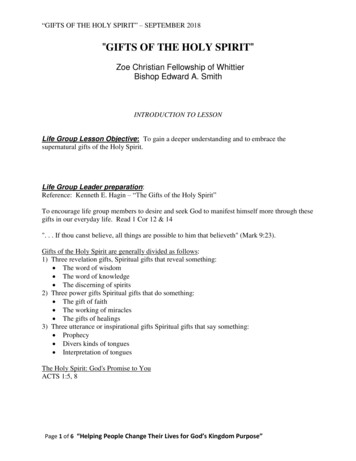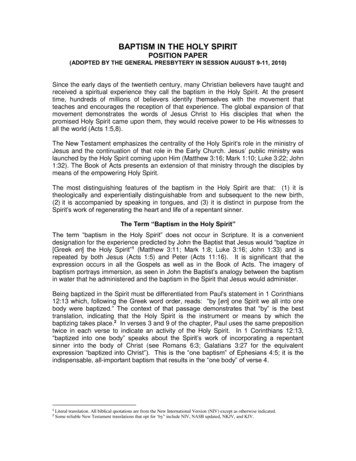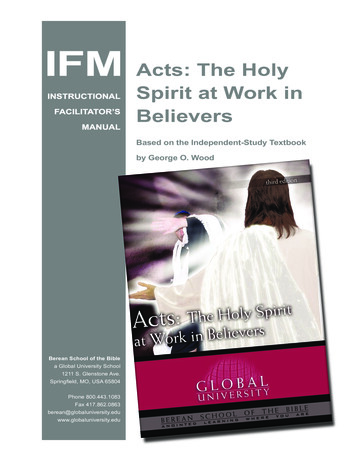
Transcription
IFMINSTRUCTIONALFACILITATOR’SMANUALActs: The HolySpirit at Work inBelieversBased on the Independent-Study Textbookby George O. WoodBerean School of the Biblea Global University School1211 S. Glenstone Ave.Springfield, MO, USA 65804Phone 800.443.1083Fax niversity.edu
GeorgeWoodDr. George O. Wood currently serves as the General Superintendent ofthe General Council of the Assemblies of God. The son of missionaryparents, he pastored Newport-Mesa Christian Center in CostaMesa, California, from 1971 until 1993. In addition to his pastoralresponsibilities there, he conducted two daily radio and televisionprograms and served as part-time professor at Vanguard Universityand as Adjunct Professor of Preaching at Fuller Theological Seminary.During this time he served as the assistant superintendent of the SouthernCalifornia District of the Assemblies of God from 1988 until 1993. Priorto being elected as the chief executive officer of the Assemblies of God,Dr. Wood served the Fellowship as its general secretary for fourteenyears. He has authored five books and numerous articles in Christianperiodicals.After receiving his bachelor of arts degree from Evangel University inSpringfield, Missouri, he earned a juris doctorate from Western StateUniversity College of Law in Fullerton, California. He also holds theDoctor of Pastoral Theology degree from Fuller Theological Seminaryin Pasadena, California. Dr. Wood is an attorney and a member of theCalifornia State Bar.IFM Design andDevelopmentThis IFM was designed and written by Between the Lines CreativeServices in Springfield, Missouri. Editing, development, and productionservices were provided by Global University staff and faculty.Global UniversitySpringfield, Missouri, USA 2010 Global UniversityAll rights reserved.Unless otherwise indicated, Scripture is taken from the Holy Bible,NEW INTERNATIONAL VERSION . Copyright 1973, 1978, 1984International Bible Society. All rights reserved throughout the world.Used by permission of International Bible Society.TO BE USED WITH:Acts: The Holy Spirit at Work in Believers Independent Study TextbookPN 01.10ISBN 978-0-7617-1567-2Printed in the United States of America
CONTENTSContentsINSTRUCTIONS TO THE FACILITATOR. viPREPARING STUDENTS FOR FINAL EXAMS.xSession 1Understanding Acts. 13Session 2From the Resurrection to Pentecost. 19Session 3The Holy Spirit Is Poured Out. 26Session 4The Birth of the Church. 32Session 5Peter and John Heal a Lame Man. roaching Acts. 13Appreciating Acts. 15Analyzing Acts. 16The Gift Our Father Promised. 19The Work of the Church. 21Steps to the Baptism in the Holy Spirit. 23Pentecost Fulfilled. 26Signs of Spirit Baptism. 28Purposes of Speaking in Tongues. 29Responses to Pentecost. 32The Pattern of Peter’s Preaching. 34The Biblical Pattern of a Dynamic Church. 35Embracing the Needs around Us. 38Explaining the Gospel. 40Enduring Hardship and Testing. 41
ivSession 66.16.26.3Session 77.17.27.3The Growth ofthe Church. 44The Purifying of the Church. 44The Powerful Church. 46The Persistent Church. 47Stephen: What Good Can Comeof Trouble?. 49Conflict in the Church. 50Stephen’s Arrest and Trial. 51The First Martyr. 54Session 8Scattered Seed: The Church Expands. 57Session 9The Acts of the Apostles. 65Session 10The First Missionary Journey. 73Session 11The Second Missionary Journey. 80Session 12Paul’s Third Missionary Journey. 88Session 13Paul’s Journeyto Rome. .213.113.213.3Mass Evangelism. 58Personal Evangelism. 60Seed for Future Harvests. 62Peter’s Expanding Ministry. 65Antioch: The Changing Shape of the Church. 68Jerusalem: The Difficult Will of God. 69To Galatia: On the Cutting Edge of Spiritual Growth. 74The Galatian Ministry: How to Minister Successfully. 75The Jerusalem Council: A Biblical Pattern of Conflict Resolution. 76The Second Missionary Journey Begins. 80A Tale of Three Cities. 83Corinth: The Final Leg of the Journey. 85Ephesus: Battle for a City. 88From Ephesus to Jerusalem: The Rest of the Journey. 92Paul’s Imprisonment in Jerusalem. 94Paul’s Imprisonment in Caesarea. 96Paul’s Imprisonment in Rome. 97Visual and worksheet masters for all sessions are located atthe back of this manual for your convenience.
vPREFACEThis Instructional Facilitator’s Manual (IFM) wasdeveloped to review and reinforce the essentialelements of the course Acts: The Holy Spirit at Workin Believers. The class deliveries outlined in themanual review the course through lecture, small groupinteraction, discussion, and role-play. These elementsof communication are otherwise absent in individualdistance learning.The purpose of reviewing the course content in a class session is toreinforce, rehearse, amplify, and promote application of the materialtaught in the course. The instructional material provided in this manualis to be considered supplemental to the corresponding course materialand should in no way replace the content of the course. Students must beencouraged to study and review their own course materials thoroughlyand not rely on class sessions as their sole means of instruction.All components necessary for facilitating a classroom review of thecourse content are included in this manual. Downloadable and interactiveelectronic files of the material are also provided on the enclosed CD.Ask God to help in the preparation and presentation of the course. TheActs: The Holy Spirit at Work in Believers course and this IFM havebeen designed to enable students to further God’s kingdom. “The Lordgives wisdom, and from his mouth come knowledge and understanding”(Proverbs 2:6).Any questions or comments concerning this manual should beaddressed to:Berean School of the BibleA Global University School1211 South Glenstone AvenueSpringfield, Missouri 65804-0315Phone: (800) 443-1083Fax: (417) 862-0863E-mail: berean@globaluniversity.eduWeb: www.globaluniversity.edu
viINSTRUCTIONSThe purpose of this Instructional Facilitator’s ManualTO THEis not to tell you how to conduct your class sessions.FACILITATORRather, it is a manual with suggestions on how youcan most clearly and logically present the material.The purpose of having a classroom experience aroundthe course content is to ensure that the studentsenrolled in the course comprehend the material andcan successfully complete the course and relatedexams. Each session of this course will offer a varietyof classroom activities and resources.What ThisManual IncludesSession ContentsIncluded in this facilitator’s manual is a complete set of lesson plansand instructional aids for your class presentations. The manual contentis divided into sessions that correspond directly to the chapters in thecourse’s Independent-Study Textbook (IST). Feel free to modify thepresentation to match your personal style, class time available, and theunique needs of the students.The content for each session includes: A quick reference to the IST lesson titles and objectives. Topical elements essential for minimal content mastery,indicated by (a checked box). Additional topical elements for extended classroom sessions,indicated by (an empty box). Logos Digital Library Research references. These arehyperlinked in the PDF file to study materials in the LogosDigital Library System (DLS) for use by those who have thisbiblical research software.Compact DiscVisualsWorksheetsThe CD provided with this manual contains an interactive PDF versionof the IFM manual, digital files of worksheets, and the PowerPointpresentations.The lesson plans in this manual prompt the facilitator to display visualsindicated by a number and title. These visuals can be displayed as bothoverhead transparencies and PowerPoint slides. Paper masters for preparingoverhead transparencies are provided in this manual in the section labeled“Visuals.” Overhead transparencies can also be created by printing directlyfrom PDF files on the CD. PowerPoint slides are provided on the CD.The lesson plans in this manual prompt the facilitator to distributeworksheets and other printed material. These worksheet handouts are
viiidentified by number and title. Paper masters for photocopying are providedin this manual in the section labeled “Worksheets.” These worksheets canalso be produced by printing from the PDF files provided on the CD.How to UseThis ManualYou are not expected to use all the material or suggestions providedfor each session. Instead, this manual is intended to provide all thematerial necessary for you to build your own presentation for the classtime you have available. The manual allows you to select which sessioncomponents you will include in your teaching sessions.Each chapter in the IST is represented by a session in this IFM. Thisallows you to allocate an entire class to one session or combine severalsessions together into a single class presentation. You may also chooseto extend a single session over more than one class presentation. Forexample, some study groups will review an entire course in a few hoursusing a seminar approach. Other groups will extend the course studyover several weeks or months of classes. This manual is intended toaccommodate any class structure or format.Essential elements that will help students master the core content of thecourse and adequately prepare for a final exam are indicated by checkedboxes in the left margin. These checked items indicate the minimalmaterial that should be covered to adequately prepare students for a finalexam. (Facilitators should read and understand the section below,titled “Preparing Students for Final Exams.”) Unchecked boxesappear next to all other elements, allowing facilitators to mark thoseadditional elements they intend to include in their class presentation.Building YourPresentationStudy the IST content until you are confident you have mastered thematerial. Make sure you are thoroughly versed in all related Bible texts.1. In addition to the filled checkboxes, select other IFMcomponents you intend to present based on the availableclass time and the goals of your class study.a. Select additional session components you wish to includeby marking the blank checkboxes on the printed pages ofthe IFM, orb. Click the empty checkboxes in the interactive PDF fileon the CD. After you have built a presentation using thePDF document, save the file to your personal computer.You may open and modify this PDF file as often as youlike or create different presentations and save them underdifferent file names.2. Enter lecture and discussion notes in the margins of eachpage in the PDF document. You may also write in themargins of the printed IFM pages.3. Locate and prepare visuals and worksheets corresponding tothe checked boxes.
viiia. Prepare visuals by selecting PowerPoint slides from theCD (you will probably want to save the PowerPoint filesto your computer). Assemble these slides into a slideshow that corresponds to your custom presentation. Usethe Custom Show menu in PowerPoint to select slides foryour classroom session. This will allow you to display theslides consecutively as you work through your material.Note: The PowerPoint slides for all pre-checked visualshave been assembled for you in a quick-review slideshow. To use this slide show, click on the “Quick-reviewSlide Show” in the left corner of the title slide.b. If you are using overhead transparencies, create theseprior to class time, and have them available in order,according to your presentation.c. Print or photocopy enough worksheets or handouts toaccommodate your number of students.d. Practice with your PowerPoint slideshow to confirm thatselected slides are available and in the appropriate orderrelative to your presentation.4. If you own a Logos Bible Software digital library, studythe resource material listed at the end of each session. Thisresearch will equip you with complementary knowledge tosignificantly enhance your students’ learning experience.5. Keep reviewing the IFM material you have selected untilyou are confident enough to deliver a clear presentation andadequately prepared to address students’ questions.Logos LinksIf you have the Logos DLS software, you may want to add backgroundmaterials or items of interest to your class time from the rich store ofmaterials in the Logos library. Clicking on the links in the Logos DigitalLibrary Research box at the end of each session in the PDF file will takeyou to specific materials in the Logos Leaders Library that address topicsof interest from that session.Berean School of the Bible courses are also available from Logos BibleSoftware for use within a Logos DLS. The various libraries are availablefor purchase at a discounted price from Global University. For moreinformation about Logos Bible Software library systems and Bereancourseware, go to www.globaluniversity.edu.Teaching MethodsLectureYou are not expected to use all the material or suggestions provided foreach session. Instead, this manual is intended to provide all the materialnecessary for you to build your own presentation for the class time youhave available. The manual allows you to select the session componentsyou will include in your teaching sessions.A lecture is a discourse before an audience for the purpose of instruction.While lecture is popular for its ease of use, in comparison with othermethodologies, it is less effective in aiding understanding and retention
ixof material. For this reason, facilitators should make only limited use ofthis teaching method.Question onal SharingQuestions are used to communicate (rhetorical learning) and testknowledge (factual learning) as well as to guide and facilitate discussion(thinking ability).We encourage you to make use of a variety of techniques to promoterelevant, fruitful, and guided discussion. Kenneth Eble summarizesdiscussion as “a context where the students can voice their specificquestions, confusions, and doubts and where they can put ideas together,frame hypotheses, and be assisted in their ability to learn on their own”(Eble, Kenneth. 1988. The Craft of Teaching. San Francisco: JosseyBass, 85).Role-playing allows learners to actively engage in the material beingstudied. Physical involvement through dramatization reinforces subjectmaterial because it provides visualization and application (Eble, 36).The facilitator’s personal experiences can be a significant benefit tostudents. However, accounts of personal ministry experience shouldbe carefully chosen for relevance to the topic and the students. Thesepersonal accounts should be limited so as not to dominate the discussion.
xPREPARINGBerean School of the Bible courses are designed toSTUDENTSbe used by individuals who are studying on theirFOR FINALown; however, learning is enhanced when studentsEXAMSstudy in groups with a facilitator. The study centerand District School of Ministry options providerelational networking, motivation, accountability,and enrichment for busy adults who sometimes needencouragement and accountability.A quality experience for students in such a group learning environmentlargely depends on committed and motivated facilitators. Suchcommitted facilitators will naturally be concerned about how theirstudents perform on the final exams. Since final exams are designedto measure students’ success in mastering the course content, it isunderstandable that facilitators will focus on preparing students to dowell on these exams.It is extremely important that facilitators, as well as group administrators,understand the meaning of a final exam and the significance of a finalcourse grade. How course material is reviewed in preparation for afinal exam will determine what a final grade actually means and itssignificance in measuring student mastery.Berean School of the Bible final exams are designed to measure students’mastery of the full breadth of each course’s content. This means that theexam score represents approximately how much of the course content astudent learned. For example, a final exam score of 43 correct answersout of a possible 50 questions indicates that the student masteredapproximately 86 percent of the course content. The final exam gradewill only have this accuracy if, prior to taking the exam, no one identifiesfor the student specific questions or information that will appear in theexam.The meaning of a final grade is altered if a student has previousknowledge about exam questions. If a student is informed about what anexam’s questions will cover prior to taking the test, the student’s scorewill not reflect mastery of the course’s breadth. Instead, it will onlyreflect mastery of the questions contained in the exam. For example, afacilitator reviews the course content but also indicates each piece ofinformation that will be included on the final exam. The final exam gradefor students exposed to such a review cannot be said to measure masteryof the entire course content. Instead, the exam score only indicatesmastery of the specific information related to test questions.
xiIt is critical to an educational program administered nationwide that finalcourse grades reflect a standard meaning. The integrity of the BereanSchool of the Bible transcript grades can be compromised if somestudents are being tested over the entire course content and others testedonly over limited and pre-identified lists of information. The result wouldbe that Berean grades would not retain a standard, accurate meaningregarding student achievement.Therefore, it is crucial that facilitators do not identify for studentsinformation that will be included on their final exams. This does notmean that facilitators should avoid reviewing tested material or preparingstudents to do well on the final exam. These IFMs are designed tofully prepare students for the exams. Facilitators who include all of theprechecked components in their sessions will have covered all materialthat students will be tested on in the final exams. Students will beadequately prepared even though they have not been told which specificinformation will appear on the exam or the form in which questions willbe presented.Facilitators may inform students that all the material covered by examquestions will be addressed during the group sessions. However,facilitators should NOT identify specific information related to testquestions, even by subtle gestures. This standard approach will behelpful, especially for groups reviewing an entire course’s content in oneextended session, such as a seminar format.The Berean School of the Bible faculty and administration appreciateall efforts by study center and ministry school personnel to protect theintegrity of the exam process. This mutual cooperation maintains thedependable standard represented by Berean academic transcripts andhelps to ensure the quality education BSB students deserve.
12Acts: The Holy Spirit at Work in BelieversUNIT 1T H E P R E - W I T N E S S D AY S O F T H ECHURCH IN JERUSALEMSESSION1OUTLINEChapter 1Understanding Acts1.1Approaching Acts1.2Appreciating Acts1.3Analyzing ActsM AT E R I A L S N E E D E DWorksheet 1 Solving the Mystery of Who WroteActsVisual 1Solving the Mystery of When ActsWas WrittenVisual 2The BridgeVisual 3Four Themes of ActsWorksheet 2 Help Wanted: Spirit-EmpoweredMinistry Opportunities2Visual 4The Church’s MissionVisual 5Three Common Ways to OutlineActsFrom the Resurrection toPentecostVisual 6The Holy Spirit: The Gift Our FatherPromised2.1The Gift Our Father PromisedVisual 72.2The Work of the Church2.3Steps to the Baptism in theHoly SpiritWhy You Should Obey the Lord’sCommand to Be Filled with the HolySpiritVisual 8The Work of the ChurchChapter 2Worksheet 3 I am a WitnessVisual 9Steps to the Baptism in the HolySpirit
Session 1 Understanding Acts1SESSION13CHAPTER1UnderstandingActsQUICL E S S O NKRET I T L E SFEA N DRENCEO B J E C T I V E SLesson 1.1 Approaching ActsObjective1.1.1Analyze the title, author, and date of Acts.Lesson 1.2 Appreciating ActsObjective1.2.1Explain how Acts bridges the Gospels and Pauline Letters.Objective1.2.2Identify how Acts traces the growth of the church.Objective1.2.3Discuss how Acts serves as a guide for faith andapologetics.Objective1.2.4Indicate how the Holy Spirit is key to witnessing.Lesson 1.3 Analyzing ActsObjective1.3.1Explain two ways to outline Acts.Chapter IntroductionThe book of Acts chronicles the birth and growth of the early church. TheHoly Spirit powerfully changed individual lives and, through them, theworld. Starting with just over one hundred believers in Jerusalem afterJesus’ ascension, the church grew by thousands on the Day of Pentecost,increasing exponentially as the good news spread to Rome, the heart ofthe Roman Empire. Today’s world is desperate for such change—and ademonstration of such power. By pursuing the Acts blueprint, today’sbelievers can set out to win the world for God. This session overviewsActs: the example set for church growth, faith and apologetics, and theHoly Spirit’s role in spreading the gospel. Every believer is called toministry. Studying Acts will help us follow the apostles’ example inturning our world upside down in the power of the Spirit.1.1Approaching Acts Group Discussion: Although believers began calling Luke’syybook the Acts of the Apostles around AD 150, some people have
14Acts: The Holy Spirit at Work in Believersargued that a more accurate title would be the Acts of the HolySpirit. Which do you think is a better title? Explain your choice.hhThe best title for Acts may be the Acts of the Holy Spirit. Although Acts1:13 lists all the apostles’ names, most are never mentioned again. TheHoly Spirit is emphasized more than any of the apostles. Luke refers tothe Spirit more than fifty times in Acts. Review with students. If Luke were to write a book featuring you and/or your church, would the title Acts of the Holy Spirit be appropriate?Why or why not?Distribute Worksheet 1—Solving the Mystery of WhoWrote Acts. You can choose to allow students time to completethe worksheet independently or complete it as a group. DISPLAY VISUAL1Emphasize that the evidence within Acts narrows the time of its writing down to asmall window of time in which we can be quite convinced the book was written.Solving the Mystery of When Acts Was WrittenHistorical fact: Paul was first imprisoned in Rome (AD 60–63).Corollary fact: Acts chronicles this imprisonment in Acts 28.Evidence suggests: Acts was written after this imprisonment.Historical fact: Jerusalem was destroyed by the future RomanEmperor, Titus, in AD 70.Corollary fact: Acts makes no mention of this fact.Evidence suggests: Acts was written before AD 70.Historical fact: Rome burned in AD 64.Corollary fact: Nero blamed Christians, igniting a wave ofpersecution.Evidence suggests: Paul’s good relationship with Roman authoritiesin the book of Acts suggests it was written beforethis event.Conclusion: Most Bible teachers believe Luke wrote Actsaround AD 63. Group Discussion: Does it matter when Acts was written andyyby whom? Why or why not?hhAnswers may include the following: Gathering as much trustworthyinformation as we can about the author helps us to see that Acts isauthentic and was written in close proximity to the events it covers;placing the growth of the church into proper historical context ishelpful; when we find solid answers about things not clearly statedin Acts (time of writing, authorship), we gain assurance that we candiscover the right answers for other questions we do not yet know.
Session 1 Understanding Acts1.215Appreciating Acts DISPLAY VISUAL2Discuss why knowing the stories of Paul’s missionary journeys to places likeGalatia, Corinth, Ephesus, Philippi, and Colosse would enhance our reading ofPaul’s letters that were addressed to those churches.The BridgeIn the New Testament, Acts is a bridge between the Gospels and Paul’sletters. At first the New Testament had only two parts: the four Gospelsand the letters Paul wrote to various churches and believers. This left agap in the written history of the church. [See Visual 2 for illustration.] DISPLAY VISUAL3Review the four themes of Acts.Four Themes of Acts1. Bridging the gap between the Gospels and Paul’s letters2. Tracing the growth of the churcha. Growing numerically (from the number of believers whocould fit in one room to many thousands of Christians)b. Spreading geographically (from Jerusalem to Rome)c. Expanding missionally (from reaching only Jews to reachingSamaritans, then Gentiles)d. Growing theologically (from strict adherence to the law ofMoses to salvation by grace through faith)3. Guiding faith and apologetics4. Emphasizing the Holy Spirit’s power for witnessing and service Group Discussion: Which of the four themes of Acts seemsyymost important for you at this point in your life and ministry?Explain.hhAnswers will vary. Group Discussion: How are each of the four themes critical foryythe church and those who minister today?hhAnswers may include (1) the idea that knowing the history of thechurches illuminates the teaching in Paul’s letters to those churches;(2) tips for church growth and encouragement to evangelize; (3)many basics of the faith are clarified in Acts, such as the relationshipbetween grace and the Law; (4) we gain encouragement through theexamples of witnessing and ministering in the power of the Holy Spirit.
16Acts: The Holy Spirit at Work in Believers Review with students. Briefly summarize the four areas of church Review with students. Acts traces the growth of the church from yygrowth chronicled in Acts: numeric, geographic, missional, andtheological. Discuss how this still stands as a template for church growthin the twenty-first century. You may want to share from your ownexperience how a church you were involved with grew in all four areasand challenge students to talk about what they can do to spur growth intheir own churches in these ways.the starting point of Jerusalem, the site of Christ’s crucifixion andresurrection, to Rome, the heart of the mighty Roman Empire. Discussthe significance of this—of starting where we are and expanding oursphere of ministry and influence as God opens doors. Share your owninsights—and encourage students to share theirs—as to what lessonsfrom this we can apply to our own evangelistic and church growth goals.Group Discussion: Acts places great emphasis on the church’soutreach to people of all races and cultures. How well do you thinkchurches today are doing in following this example? Explain. Iscultural and racial unity and inclusiveness important? Is a church“failing” if it includes people of only one race or culture? Explain.hhAnswers will vary. Review with students. Perhaps Luke’s greatest purpose in Acts was to emphasize the ministry of the Holy Spirit through believers. In hisGospel, Luke stated that Jesus depended on the Spirit (Luke 4:1, 14,18). He also recorded Jesus’ promise that the Spirit would come t
Acts: The Holy . Spirit at Work in Believers. Based on the Independent-Study Textbook by George O. Wood. Berean School of the Bible a Global University School
